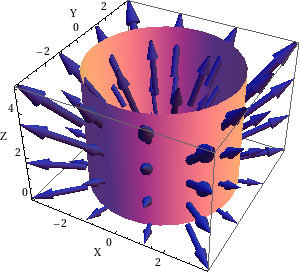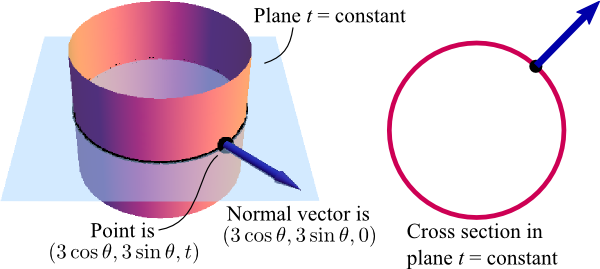Vector surface integral examples
Example 1
Let $\dls$ be the cylinder of radius 3 and height 5 given by $x^2+y^2=3^2$ and $0 \le z \le 5$. Let $\dlvf$ be the vector field $\dlvf(x,y,z) = (2x,2y,2z)$. Find the integral of $\dlvf$ over $\dls$. (Note that “cylinder” in this example means a surface, not the solid object, and doesn't include the top or bottom.)
This problem is still not well-defined, as we have to choose an orientation for the surface. Let the positive side be the outside of the cylinder, i.e., use the outward pointing normal vector.
Solution: What is the sign of integral? Since the vector field and normal vector point outward, the integral better be positive.
Parameterize the cylinder by \begin{align*} \dlsp(\theta,t) = (3 \cos\theta, 3\sin\theta, t) \end{align*} for $0 \le \theta \le 2\pi$ and $0 \le t \le 5$.
Since \begin{align*} \pdiff{\dlsp}{\theta}(\theta,t) &= (-3\sin\theta, 3\cos\theta,0)\\ \pdiff{\dlsp}{t}(\theta,t) &= (0,0,1) \end{align*} the normal vector is \begin{align*} \pdiff{\dlsp}{\theta}(\theta,t) \times \pdiff{\dlsp}{t}(\theta,t) &= \left| \begin{array}{ccc} \vc{i} & \vc{j} & \vc{k}\\ -3\sin\theta & 3\cos\theta & 0\\ 0 & 0 & 1 \end{array} \right|\\ &= \vc{i} 3 \cos\theta - \vc{j} (-3\sin \theta)\\ &= (3\cos\theta, 3\sin\theta,0). \end{align*}
Is $(3\cos\theta, 3\sin\theta,0)$ an outward pointing normal? It is a normal at the point $\dlsp(\theta,t)=(3 \cos\theta, 3\sin\theta, t)$. As shown in the below figure, it is an outward pointing normal.
One could also verify orientation by just choosing a single point, such as picking $\theta=0$ and $t=0$. In that case, the point is $(3,0,0)$ and the normal vector is $(3,0,0)$, which can be see as pointing outside the cylinder.
We can now calculate total flux. \begin{align*} \dsint &= \psint{0}{5}{0}{2\pi}{\dlvf}{\dlsp}{\theta}{t} \\ &= \int_0^5\int_0^{2\pi} \dlvf(3 \cos\theta, 3\sin\theta, t) \cdot (3\cos\theta, 3\sin\theta,0) d\theta\,dt\\ &= \int_0^5\int_0^{2\pi} (6 \cos\theta, 6\sin\theta, 2t) \cdot (3\cos\theta, 3\sin\theta,0) d\theta\,dt\\ &= \int_0^5\int_0^{2\pi} 18 \cos^2\theta + 18\sin^2\theta \, d\theta\,dt \qquad\quad\\ &=\int_0^5\int_0^{2\pi} 18 \, d\theta \, dt\\ &=\int_0^5 18(2\pi) dt\\ &= 18(2\pi)(5) = 180 \pi \end{align*}
The answer is postive, as we knew it must be. There are two orientations for the cylinder. If we had instead chosen the orientation given by the inward pointing normal vector, we would have obtained the answer $-180\pi$.
Example 2
Let $\dls$ be a disk of radius 6 centered around the $z$-axis in plane $z=-4$, oriented with an upward pointing normal. Let a magnetic field be given by $\dlvf(x,y,z) = (0,0,x^2+y^2)$. What is total magnetic flux through disk?
Solution: The total magnet flux is $\dsint$. What is the sign of this integral? Since the vector field is pointing upward and the surface is oriented with upward pointing normal vector, the integral must be positive.
We can parameterize this disk by \begin{align*} \dlsp(\theta,r) = (r\cos\theta, r\sin\theta,-4) \end{align*} for $0 \le \theta \le 2\pi$, $0 \le r \le 6$.
We calculate the normal vector through the cross product of the derivatives of $\dlsp$. \begin{align*} \pdiff{\dlsp}{\theta} &= (-r\sin\theta, r\cos\theta, 0)\\ \pdiff{\dlsp}{r} &= (\cos\theta, \sin\theta, 0) \end{align*} \begin{align*} \pdiff{\dlsp}{\theta} \times \pdiff{\dlsp}{r} &= \left| \begin{array}{ccc} \vc{i} & \vc{j} & \vc{k}\\ -r \sin\theta & r \cos\theta & 0\\ \cos\theta & \sin\theta & 0 \end{array} \right|\\ &= 0\vc{i} + 0 \vc{j} + (-r\cos^2\theta-r\sin^2\theta) \vc{k}\\ &= (0,0, -r) \end{align*} The normal vector is downward pointing, but we need to orient $\dls$ with upward normal vector. For correct orientation, we must choose the normal vector $\pdiff{\dlsp}{r} \times \pdiff{\dlsp}{\theta} = (0,0, r)$. (Otherwise, we would be off by a sign.)
Putting these pieces together, the total flux is: \begin{align*} \dsint &= \psint{0}{2\pi}{0}{6}{\dlvf}{\dlsp}{r}{\theta}\\ &= \int_0^{2\pi}\int_0^6 \vc{F}(r\cos\theta,r\sin\theta,-4) \cdot (0,0,r) dr\,d\theta\\ &=\int_0^{2\pi}\int_0^6 (0,0,r^2\cos^2\theta+r^2\sin^2\theta) \cdot (0,0,r) dr\,d\theta\\ &=\int_0^{2\pi}\int_0^6 r^3 dr\,d\theta\\ &=\int_0^{2\pi} \left( \frac{r^4}{4}\bigg|_{r=0}^{r=6} \right) d\theta =\int_0^{2\pi} \frac{6^4}{4} d\theta = 648\pi. \end{align*} The total magnetic flux is positive, consistent with what we had observed at the outset.
Thread navigation
Multivariable calculus
Math 2374
Notation systems
Similar pages
- Introduction to a surface integral of a scalar-valued function
- Introduction to a surface integral of a vector field
- Scalar surface integral examples
- The integrals of multivariable calculus
- Introduction to double integrals
- Double integrals as iterated integrals
- Double integral examples
- Double integrals as volume
- Examples of changing the order of integration in double integrals
- Double integrals as area
- More similar pages

